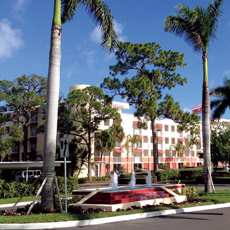
Before it made changes to its food service operation at Abbey Delray South, the Lifespace Communities facility put the cart, or charrette, before the horse.
The architects on the project incorporated a French educational design system to generate ideas about how to initiate a new culture of food, and how it is served and enjoyed.
“When the students’ projects were due, a cart (charrette) would come down the street,” said Cornelia Hodgson, president of Cleveland, OH-based c.c. hodgson architectural group. “The students would have to hurry up and finish their drawings and get them into the cart.
“What it really means is a rapid- pace design process to brainstorm lots and lots and lots of ideas so you can then come to selecting the best solutions.”
A vital part of the project was the input of those living in the Delray Beach-based community, which just celebrated its 30th anniversary.
“It really got the residents involved in a great dialogue,” said David Randazzo, executive director of Abbey Delray South. “It’s given them a great deal of ownership in the process, and it makes the transition easier for everyone.”
The previous food service in the facility’s CCRC consisted of a cafeteria-style dining room with a salad bar. It was transformed into a redesigned formal dining room, a bistro with a “grab-and-go” section and an entry lounge with a bar that serves food. Al fresco dining, which takes advantage of the Florida weather, and a private room for meals and parties are also available.
To accommodate the culinary shift, a new 5,000-square-foot kitchen was connected to the building. It accounted for the largest piece of the $6.5 million renovation, which also included a guardhouse and updates to the façade of the building. The old kitchen was transformed into additional dining space. Training of existing and new kitchen staff and servers was included in the budget.
Baby boomers have high expectations for food, experts say.
“We started to refer to the baby boomers as the food court generation in 1999,” said Hodgson. “We’re not saying that a retirement community or CCRC should have a food court, but you’re dealing with a population that is used to having more choices. And, sure enough, years later that’s exactly what more communities are doing, providing these alternate dining approaches.”
Even the old, narrow corridor into the Abbey Delray South dining room was transformed to heighten residents’ mealtime experience.
“We redesigned that to have a more gracious entry to these new dining spaces,” Hodgson said. “In these communities, the dining experience is one of the main social engagements.
“That’s really a key part of the culture. So how you enter, and the graciousness of it, is a critical factor.”
Accoutrements such as colored tablecloths and napkins remain important to the dining experience and can be used to freshen existing spaces. Theme nights, or special events like wine tastings, also can help keep the dining experience vibrant, Hodgson said.
Lessons learned
– Seek input from residents. You are making changes to their home.
– Find a resident who will act as a champion /leader/ambassador for the project.
– Make sure the culinary staff is intimately involved in the process. They must make time for design meetings.
From the March 01, 2014 Issue of McKnight's Long-Term Care News




